Cognitive therapy (CT): definition, application, and effectivity
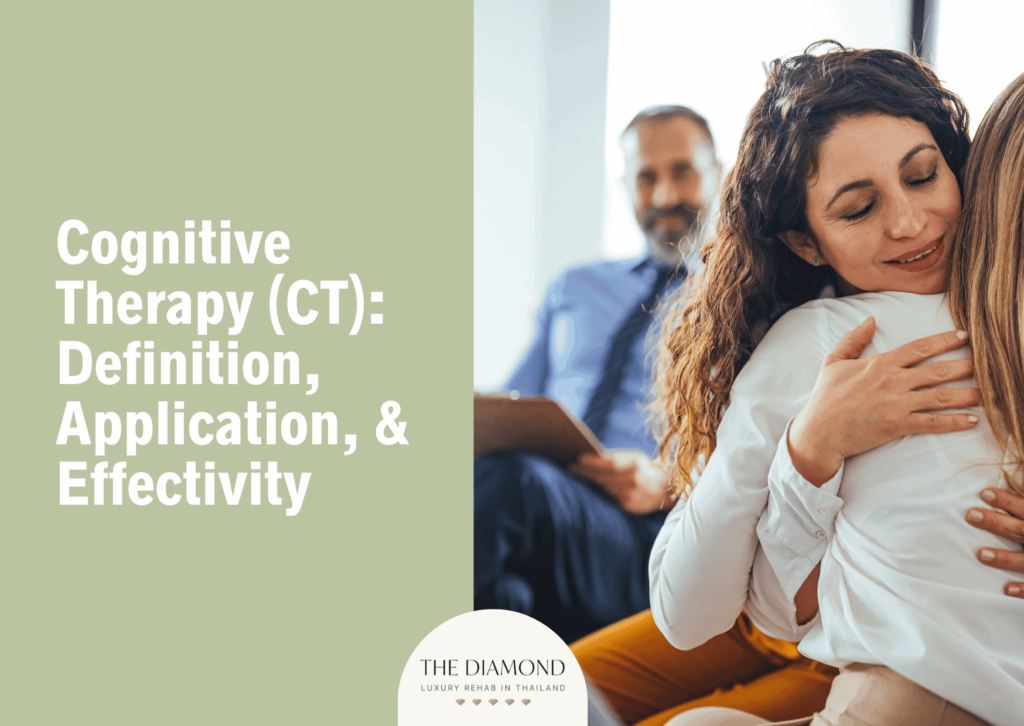
Cognitive therapy is a type of therapy whose main objective is to help people identify erroneous beliefs and thought patterns. Therapists help patients change these thoughts and beliefs so they positively influence mood and behavior. During therapy sessions, patients learn coping skills and get tools that allow them to respond to various situations and triggers in a healthier manner.
Uses of cognitive therapy are numerous, including academic achievement, addiction, anxiety disorders, bipolar disorder, low self-esteem, phobia, schizophrenia, substance abuse, suicidal ideation, and weight loss.
Since thoughts dictate emotions and behavior, cognitive therapy serves as a psychotherapy approach to noticeably reduce the intensity of mental health problems and improve a patient’s quality of life.
Cognitive therapy has been extensively researched and is considered an effective treatment for various mental health conditions. This has been confirmed by multiple scientific studies over the decades after its development.
What is Cognitive therapy (CT)?

Cognitive therapy (CT) is a form of psychotherapy that empowers patients to identify and correct false beliefs that lead to negative behaviors and moods. This type of therapy is patient-centric, goal-oriented, time-sensitive, collaborative, and educational.
Cognitive therapy in psychology is based on an information-processing model. The cognitive therapy model teaches that the way people perceive their experiences influence their behavioral, emotional, and psychological reactions.
The fundamental assumption of cognitive therapy is that thought precedes mood. The focus is on present thinking, communication, and behaviors rather than past experiences. Cognitive therapy is all about problem-solving.
The term cognitive therapy is often used as a synonym for cognitive-behavioral therapy (CBT). While they do have a lot in common, these terms are not meant to be used interchangeably.
Cognitive therapy is a therapeutic technique concerned with identifying and correcting negative beliefs as well as automatic assumptions that lead to an impaired state of mind, as mentioned above.
On the flip side, CBT is a wide spectrum of techniques that go beyond cognitive therapy. Instead, CBT is basically any method focused on changing behavior by correcting dysfunctional thought processes. Certain techniques are concerned with behavioral elements, whereas others with cognitive aspects. Basically, CBT refers to various techniques to manage mental health problems, while cognitive therapy is one of those techniques, as per a 2021 article written by William Smith for Positive Psychology.
Who created Cognitive therapy?
Aaron Temkin Beck, an American psychiatrist, created cognitive therapy in the 1960s at the University of Pennsylvania. Dr. Beck is regarded as the father of both cognitive therapy and cognitive-behavioral therapy (CBT). He developed CT with the belief that an individual’s experiences result in thoughts or cognitions. Aaron Beck’s cognitive therapy was developed specifically as a treatment for depression.
In the 1950s, Dr. Beck designed and conducted experiments whose main objective was to test psychoanalytic concepts of depression. However, his research failed to validate theories that depression was associated with retroflected hostility.
Dr. Beck didn’t let these unsuccessful attempts discourage him from learning more about depression and uncovering more effective ways to treat it. Instead, he started further investigations regarding the nature of this mental health condition.
During the work on these experiments, Dr. Beck realized the patients experienced a flood of negative thoughts that appeared spontaneously. He named them automatic thoughts. Dr. Beck additionally discovered that the content of automatic thoughts belonged to three categories such as negative ideas about themselves, the future, and the world. These cognitions are called a cognitive triad.
One of the major findings from the research was that people accepted these thoughts as is, without taking any time to reflect or challenge them.
For that reason, Dr. Beck started helping patients identify and analyze these thoughts. By doing so, he found that patients were able to think in a more realistic manner. As a result, their emotions and behavior improved.
During his prolific career, Dr. Beck published a wide range of books and works on the subject of cognitive therapy and CBT. These include Cognitive therapy and emotional disorders (1975), Cognitive therapy for depression (1979) as well as The integrative power of cognitive therapy (1988).
Once Dr. Beck developed cognitive theory and therapy for depression, he and his colleagues focused on developing a cognitive approach to managing other conditions. Dr. Beck’s cognitive therapy is based on a cognitive formulation that varies from one mental health condition to another.

While Dr. Beck developed CT therapy, other therapists contributed to its development. In fact, the roots of cognitive therapy are traced back to ancient times, specifically Stoicism.
Stoicism is a school of philosophy from ancient Greece and Rome in the early 3rd century BC. This philosophy maximizes positive emotions, helps a person hone their virtues of character, and reduces negative emotions. Stoic philosophers believed that a person uses logic to identify and eliminate false beliefs that cause distressing emotions.
Stoics believed all nature is to be accepted and recognized that we don’t have complete control in every aspect of life, but we are the one who control our thoughts and feelings. Using logic to identify irrational thoughts, accepting our circumstances, and making a clear distinction between things we are and aren’t able to control is what makes Stoicism similar to cognitive therapy.
Stoic philosophers inspired several therapists and cognitive theorists. Before Dr. Beck developed the cognitive therapy we know today, an American psychologist Dr. Albert Ellis worked on similar ideas in the 1950s. Dr. Ellis named his approach rational therapy, which later turned to rational emotive therapy, and finally rational emotive behavior therapy. This approach focused on helping patients identify negative thoughts and irrational beliefs that contributed to emotional or behavioral problems.
The cognitive revolution in psychology occurred in the 1970s. Merging cognitive therapy techniques and behavioral modification techniques led to the development of cognitive-behavioral therapy.
Stoic philosophers inspired many therapists and cognitive theorists. Before Dr. Beck developed the cognitive therapy we know today, an American psychologist Dr. Albert Ellis worked on similar ideas in the 1950s. Dr. Ellis named his approach rational therapy, which later turned to rational emotive therapy, and finally rational emotive behavior therapy. This approach focused on helping patients identify negative thoughts and irrational beliefs that contributed to emotional or behavioral problems.
The cognitive revolution in psychology occurred in the 1970s. Merging cognitive therapy techniques and behavioral modification techniques also led to the development of cognitive-behavioral therapy.
Major contributions to the development and evolution of cognitive therapy came from psychologists and psychotherapists Arnold Lazarus, Donald Meichenbaum, Michael J. Mahoney, and Marvin Goldfried.
Nowadays, cognitive techniques are among the most common (and effective) approaches in the management of various mental health problems and substance use disorders.
When did Cognitive therapy become popular?
Cognitive therapy became popular in the 1970s, when the internal thought processes, i.e. self-talk, began to be considered as targets and mechanisms of change alike. Improving cognitive abilities was prioritized over changing behavior, a paper by Benjamin et al., from the April 2011 issue of Child and Adolescent Psychiatric Clinics of North America reported.
The 1970s and 1980s were mainly reserved for developing protocols in using cognitive psychotherapy to treat various mental health problems.
Cognitive therapy is divided into three waves. The first wave occurred before Dr. Beck, the second wave belongs to Dr. Beck and other psychotherapists who played a role in the development of cognitive therapy, and the third wave started in 1990. Cognitive therapy became more mainstream with the third wave, which focuses on more comprehensive life goals and accepting our thoughts within context instead of judging them.
The popularity of cognitive therapy keeps growing with the reduction of social stigma around mental health problems and addiction.
Where is Cognitive therapy used?
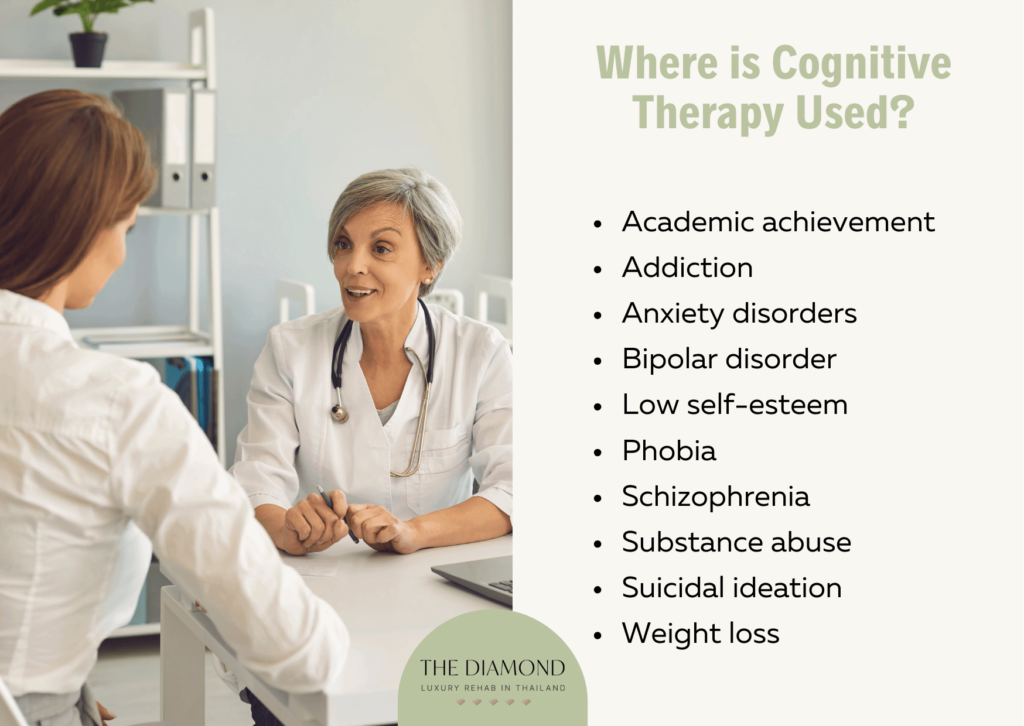
Cognitive therapy is used for the treatment or management of various mental health conditions or challenges affecting a person’s psychological and emotional health and well-being. The most common uses of cognitive therapy are listed below:
- Academic achievement
- Addiction
- Anxiety disorders
- Bipolar disorder
- Low self-esteem
- Phobia
- Schizophrenia
- Substance abuse
- Suicidal ideation
- Weight loss
1. Academic achievement
Academic achievement refers to the extent to which a student, institution, or teacher has attained their short- and long-term educational goals. The academic environment tends to be competitive and puts a lot of pressure on everyone involved. Achieving academic success is a dream for most individuals, but it takes a toll on one’s mental health.
In fact, findings of a 2015 study by Murphy et al., published in Child Psychiatry & Human Development revealed that mental health was a key indicator of future academic achievement, with students who improved their mental health between first and third grade making greater academic progress than those whose mental health remained unchanged or deteriorated.
That’s where cognitive therapy steps in. Cognitive therapy works by helping students correct distorted thinking and maladaptive patterns of behavior, which are behind academic struggles. Behavioral modification through cognitive therapy helps students achieve the academic success they study for.
Instead of focusing on negative self-talk that says certain academic goals are out of reach, cognitive therapy empowers a person to understand those thoughts aren’t rational. The patient adopts new skills and coping mechanisms that allow them to resist or eliminate those thoughts and embrace more realistic thought patterns. This leads to wiser choices and positive behavior change.How quickly cognitive therapy improves academic performance depends on the patient and the progress they’re making. Certain people need sessions over the course of 90 days i.e. three months. Others need more or less than that.
2. Addiction

What is addiction? Addiction is a neuropsychological disorder indicated by a compulsive need to use substances or do certain activities despite the harm they cause. People develop an addiction to alcohol, drugs, gambling, pornography, sex, shopping, or stealing.
Research has shown that mental disorders can be a factor in substance use and SUDs, according to an article titled, “Substance Use and Co-Occurring Mental Disorders” last updated in March 2023 by the National Institute of Mental Health. Having a dual diagnosis means a person has both addiction and a mental health disorder, although one doesn’t necessarily have to cause the other.
The cognitive theory states that individuals prioritize addictive behaviors over healthy ones as a result of their own expectations. They expect that the benefits and risks of addictive behaviors outweigh those of healthy behaviors. For instance, a person mistakenly believes that refusing to satisfy cravings leads to harm. In this case, cognitive therapy works by enabling a person to cultivate more precise expectations regarding addiction and craving.
They realize that the thoughts they have are irrational and start making healthier decisions. A therapist works on addressing underlying mental health problems too. How quickly a person recovers from addiction through cognitive therapy depends on the severity of the addiction and the type of treatment. In inpatient programs, it usually takes 30 to 90 days or longer.
3. Anxiety disorders
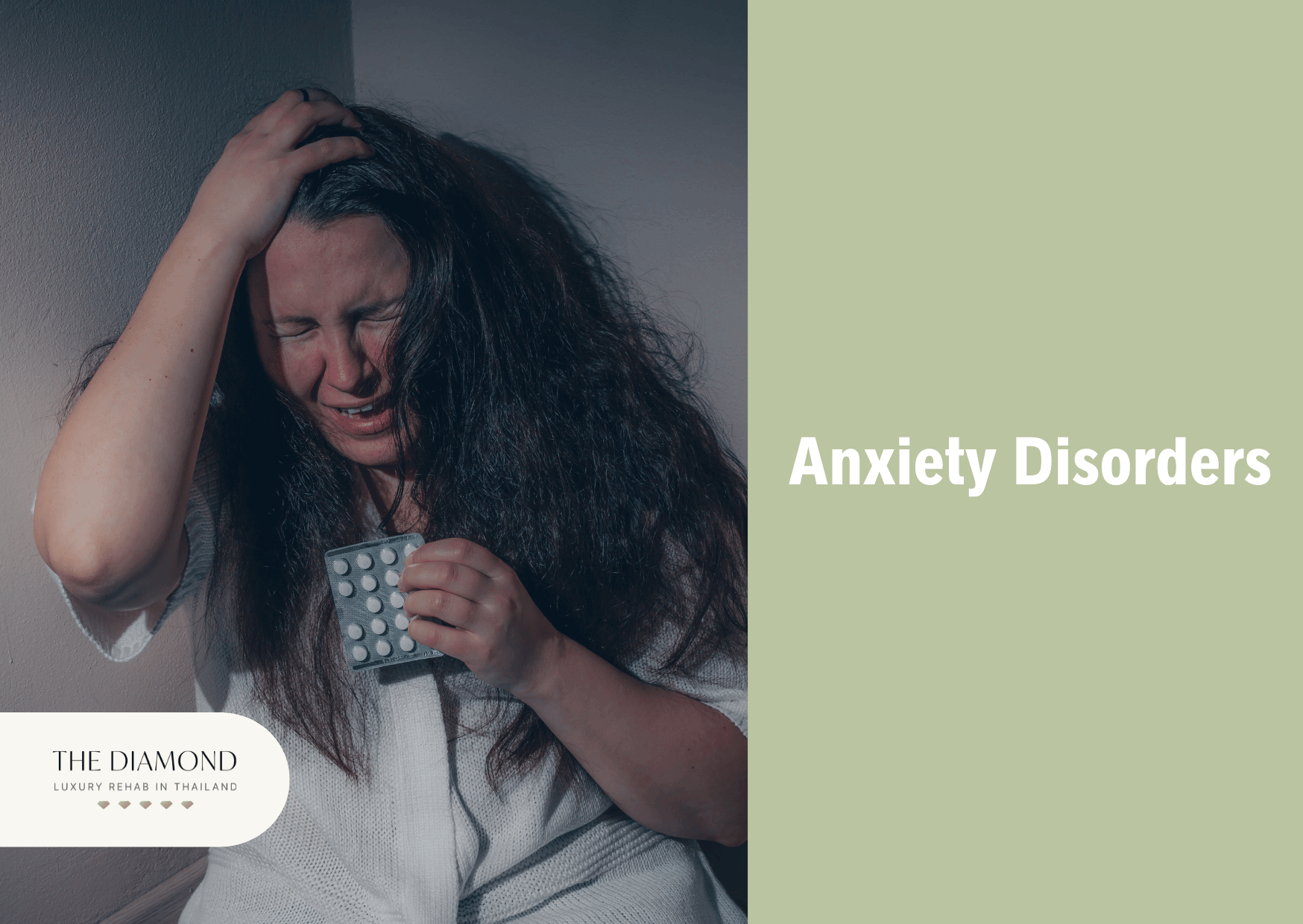
Anxiety is defined as a feeling of unease, intense fear, worry, panic, or feeling threatened in certain situations or places. In fact, anxiety is a term that refers to various disorders with these symptoms. These disorders include PTSD, generalized anxiety disorder, panic disorder, and social anxiety.
When left untreated, anxiety disorders have disastrous consequences such as recurring panic attacks and complications that affect a person’s daily functioning. Cognitive therapy is helpful for patients with anxiety.
It works by enabling a person with anxiety to understand their thoughts are irrational. Focusing on these thoughts worsens their symptoms and contributes to panic. During cognitive therapy sessions, patients learn how to correct these irrational beliefs in order to reduce the intensity of symptoms they’re experiencing.
For example, a 2015 study by Antonia N. Kaczkurkin and Edna B. Foa from the Dialogues in Neuroscience confirmed that cognitive therapy works for persons with generalized anxiety disorder and other types of anxiety. Cognitive therapy teaches patients to challenge thoughts that overestimate risk and identify and modify catastrophic thinking.
Patients with anxiety often feel like they have no control over their thoughts or the situation they’re in. The role of cognitive therapy is to help them regain that control. For certain people, cognitive therapy for anxiety disorders works within one to two months, whereas others need three to four months.
4. Bipolar disorder
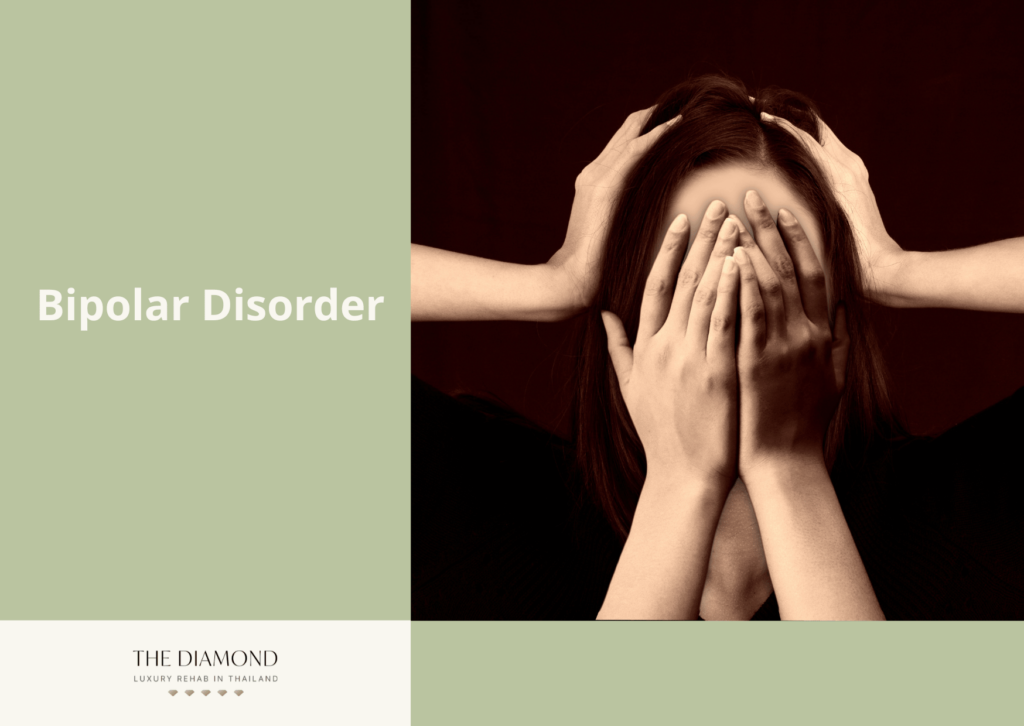
Bipolar disorder is a type of mental health condition that causes extreme mood swings indicated by episodes of emotional highs (mania) and lows (depression). Failing to treat bipolar disorder causes even more severe depression or full-blown mania. Patients usually need a combination of medications and therapy to improve their quality of life.
Cognitive therapy for bipolar disorder works by addressing depressive symptoms that patients experience. For example, it helps patients address and overcome feelings of guilt and other negative thoughts they have about their manic episodes.
A 2017 meta-analysis by Chiang et al., published in PLoS One showed that the cognitive approach is effective at reducing the severity of mania and depressive symptoms, as well as improving psychosocial functioning in participants with bipolar disorder. In addition, this kind of therapy reduces relapse.
Relying on medications alone isn’t enough, which is why cognitive therapy stabilizes a patient’s mood and keeps their life on track. With effective treatment, episodes in persons with bipolar disorder improve in about three months.
Keep in mind that bipolar disorder requires lifelong management, which is why it’s important for patients to see a cognitive therapist as long as it’s necessary. This is important even if a person feels fine at the moment.
5. Low self-esteem
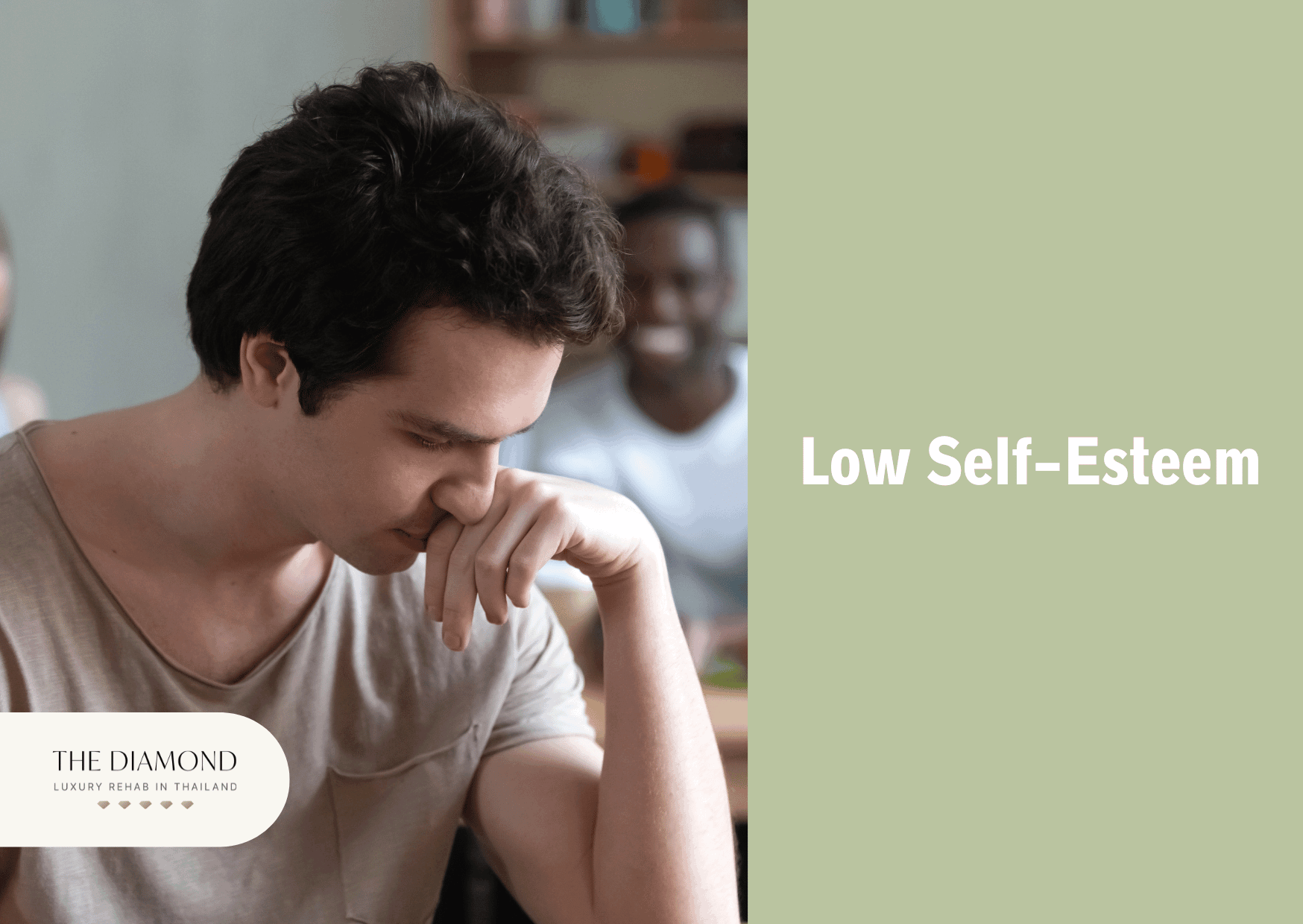
Low self-esteem is a low opinion of oneself. A person with low self-esteem lacks confidence in who they are or what they’re able to do. While having low self-esteem isn’t a mental health problem per se, it is closely linked with depression and anxiety.
A 2003 study by Peter H. Silverstone and Mahnaz Salsali from the Annals of General Hospital Psychiatry found that there is a direct correlation between the onset of psychiatric diseases and poor self-esteem. As a result, having a mental illness raises the risk of developing psychiatric disorders, and having a mental illness itself reduces one’s self-esteem.
Low self-esteem prevents a person from achieving their full potential and worsens their mental health. Cognitive therapy is one of the most important strategies to improve self-esteem. It works by targeting assumptions such as lack of ability or other thoughts a person has about themselves. The therapist helps a patient challenge these thoughts so they understand that those beliefs are irrational and inaccurate.
The goal of cognitive therapy is to make sure a patient becomes more confident and overcomes the mental blocks created by negative thought patterns. How quickly cognitive therapy improves self-esteem isn’t the same for everyone. Three to six months work for most people, though.
6. Phobia

Phobia is defined as an irrational and uncontrollable or persistent fear of something, someone, or a situation. It’s not the same as fear, which is a normal reaction. Phobia occurs due to an unrealistic or exaggerated sense of danger about an object or situation.
When left untreated, phobias significantly impact and limit a person’s quality of life. Cognitive therapy enables a person to manage their phobia by helping them to gradually and slowly change the way they think. The therapy is based on the interconnectedness of beliefs, thoughts, and behaviors. A therapist is likely to combine cognitive therapy and exposure therapy.
What cognitive therapy does is that it doesn’t simply aim to convince a person their phobias are irrational and inaccurate. The therapist teaches patients skills to challenge their thoughts so they adopt a more realistic perspective.
Patients additionally learn how to react to triggers of their phobias in a healthier manner. By slowly changing their thought pattern, patients with phobias are able to put their problems under control so they have a normal and healthy life. In a 2009 study by Priyamvada et al., published in the Industrial Psychiatry Journal, 17 sessions were necessary for a patient with social phobia to experience significant improvement.
7. Schizophrenia
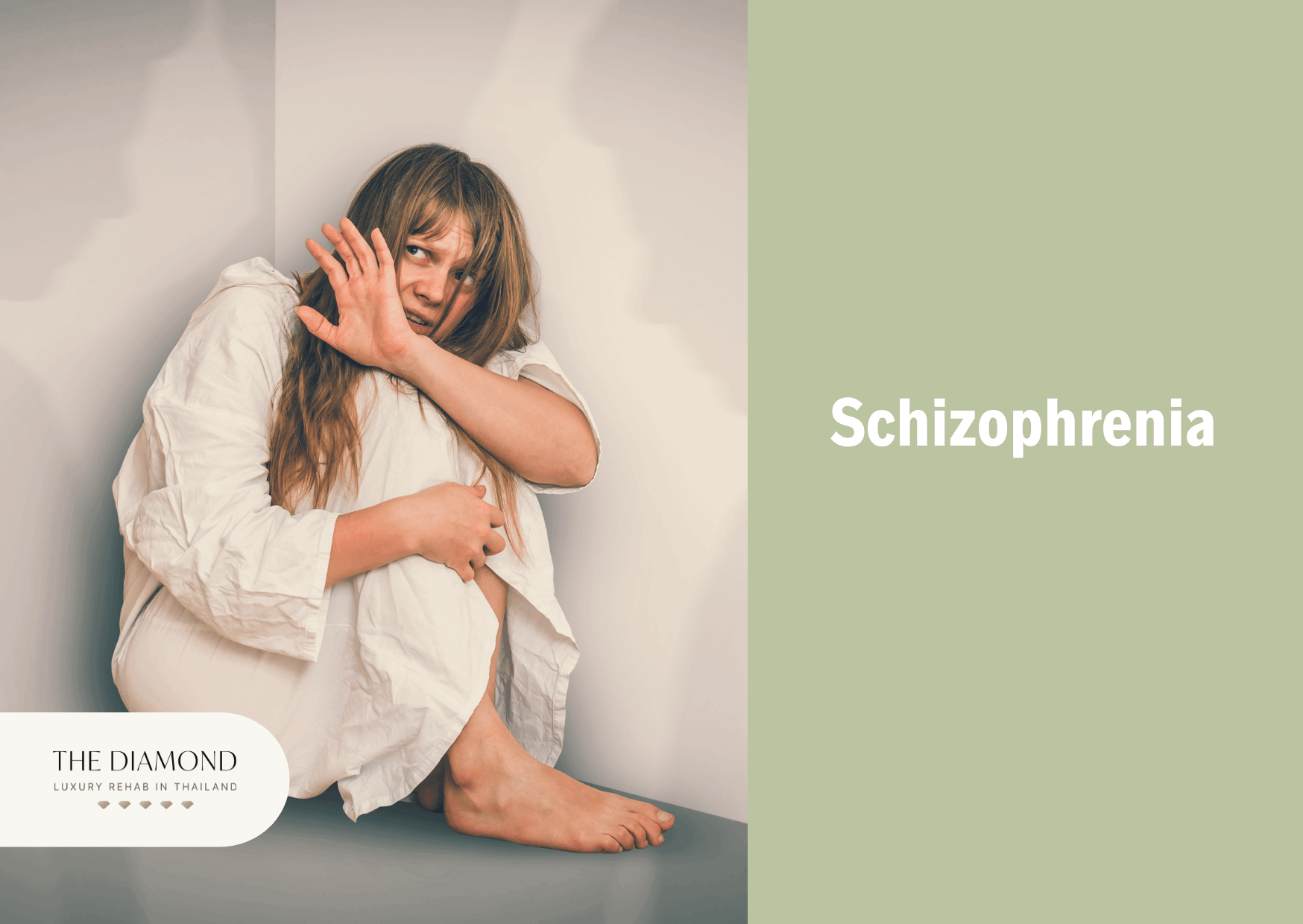
Schizophrenia is a serious mental health disorder indicated by an abnormal interpretation of reality. People with this disease have disordered thinking, hallucinations, and delusions that affect their daily functioning. Schizophrenia interferes with an individual’s ability to think clearly, make decisions, perceive reality, or manage emotions.
Cognitive therapy helps persons with schizophrenia through the development of social and problem-solving skills. Initially, cognitive therapy for schizophrenia was developed to address residual symptoms caused by medications, but today it is considered an effective intervention.
In 2014, The Lancet published a study by Morrison et al., which concluded that for patients who have opted not to take antipsychotic medications, cognitive therapy appears to be a safe and acceptable substitute that considerably reduced psychiatric symptoms. Cognitive therapy additionally improved personal and social functioning among participants.
Since patients with schizophrenia have an abnormal perception of reality, cognitive therapy enables them to improve the way they perceive the world around them. Schizophrenia is a serious disease that requires lifelong management, even when symptoms subside. It takes several months to feel better with regular therapy sessions.
8. Substance abuse
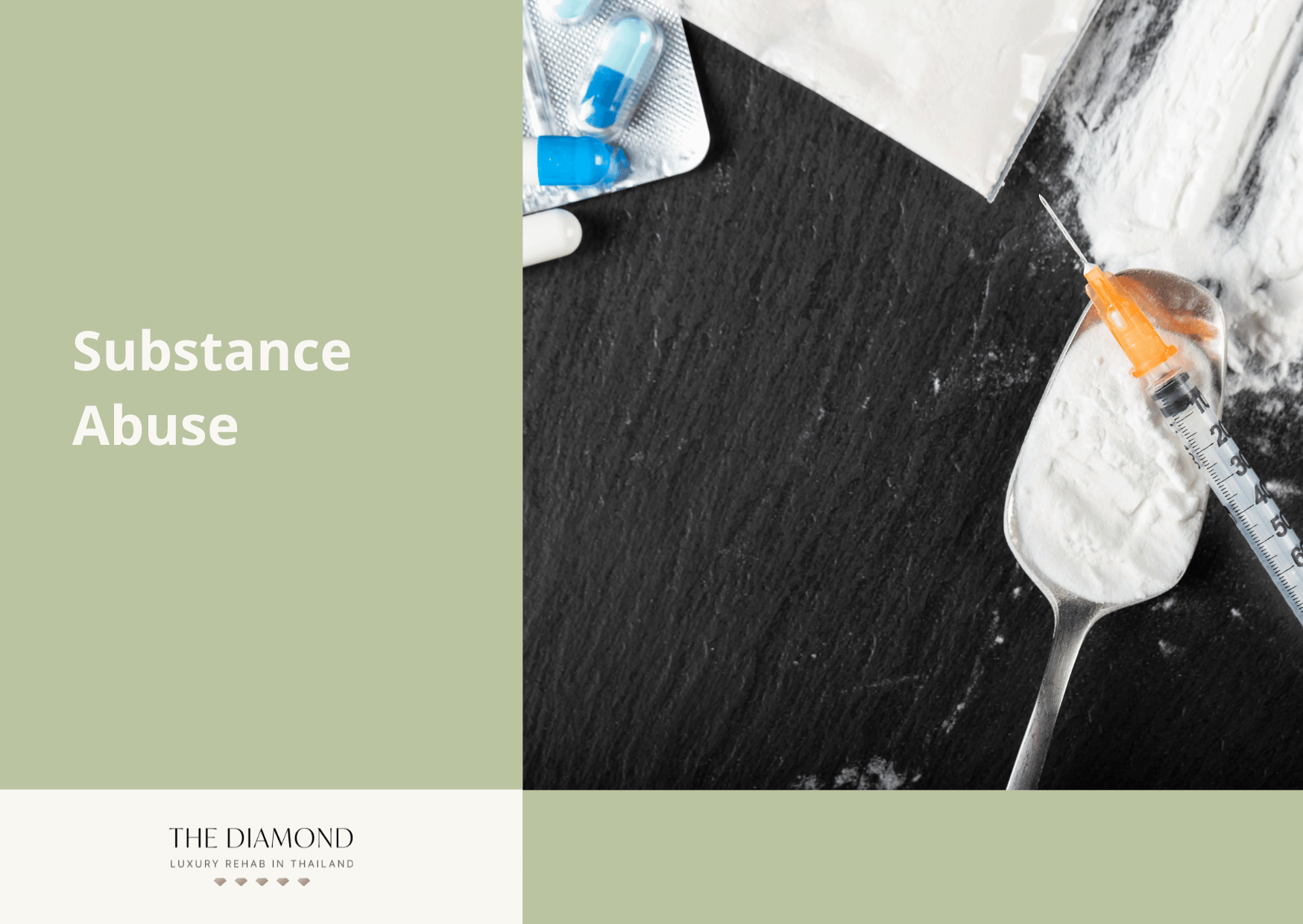
Substance abuse is the use of illegal drugs or the abuse of prescription medications. Substance abuse doesn’t mean a person is addicted, but it indicates problematic use of a specific substance. It leads to addiction as well as social, physical, and emotional problems in a person’s life.
A person with mental health problems has a higher substance abuse risk. That happens because they start using alcohol or drugs as an escape from their thoughts and emotions. At the same time, substance abuse worsens existing mental health problems.
Cognitive therapy for substance abuse works by helping people dismiss false beliefs or irrational thoughts that trigger substance abuse. Plus, it teaches them more effective communication skills and provides self-help tools for a better mood. By focusing on correcting irrational thoughts that lead to substance abuse, a patient is one step closer to overcoming their problem.
For example, a person uses a particular substance to perform better or relax. Their mind keeps telling them it’s impossible to achieve that without the drug. The thought pattern leads to action where a person indeed keeps taking the substance. Cognitive therapy targets that faulty thought system by showing a person the thoughts that triggered substance abuse are inaccurate.Since substance abuse isn’t addiction per se, it’s likely to take a couple of weeks for a person to overcome this problem with cognitive therapy. Of course, these effects vary from one person to another.
9. Suicidal ideation
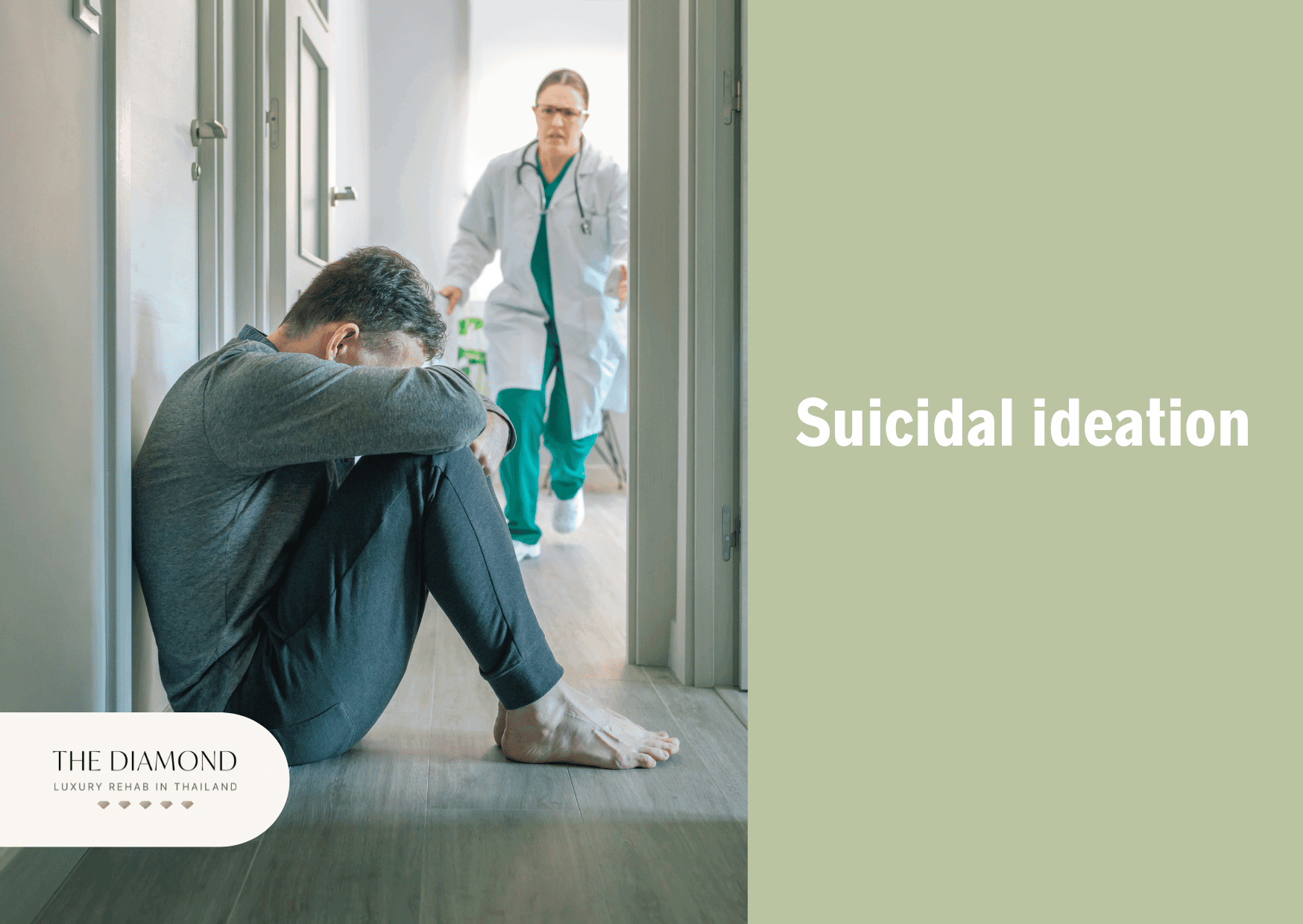
Suicidal ideation is a term that refers to thinking about suicide with or without a plan to kill yourself. People start having suicidal thoughts and tendencies due to several causes including depression and addiction.
Cognitive therapy stands as a practical method for the prevention of suicidal ideation and tendencies. It reduces symptoms of mental illnesses linked to a higher risk of suicide including depression, anxiety, and psychosis.
The cognitive theory suggests that a person considers suicide if they see no solution to the problem that is causing them pain. The therapy works by identifying the perceived unsolvable issue in order to decrease cognitive distortions and errors in logic. Cognitive therapy aims to improve a person’s problem-solving skills, boost their motivation, and lower perceived emotional pain.
Through cognitive therapy, a patient learns every problem has a solution. They further learn that certain thoughts in our minds aren’t correct. Once they start thinking beyond that, it’s possible to reduce the risk of future suicidal tendencies.There is no specific time frame during which cognitive therapy needs to work. People with different conditions need a few weeks or months to feel better. It is likely the same for suicidal ideation too.
10. Weight loss

Weight loss refers to the reduction of body mass, typically involving a decrease in body fat and/or lean mass. It is often pursued for various reasons, including health improvement, aesthetic goals, or addressing medical conditions.
Weight loss is a mission for numerous people, and it has a major impact on mental health. In fact, a study by Lasikiewicz et al., published in the January 2014 issue of the journal Appetite showed that people who took part in a behavioral and/or dietary weight loss intervention saw improvements in their health-related quality of life, depressive symptoms, self-esteem, and body image. These benefits were seen both after the intervention and one year later, with and without exercise.
However, attempts to lose weight is a potential source of stress as well. When left unmanaged, this problem leads to serious complications and unhealthy moves to lose weight.
Cognitive therapy for weight loss works by enabling patients to understand and change unhelpful eating and lifestyle habits. By addressing these habits, a person is able to adopt healthier routines that lead to sustainable weight loss. In this case, sustainable weight loss refers to the result a person has the ability to maintain without the yo-yo effect.
The biggest obstacle to successful weight loss is in a person’s mind. That irrational thinking only aggravates unhealthy eating habits and sedentary lifestyles. Cognitive therapy empowers a person to change unhealthy patterns so they’re committed to maintaining their goals. Changing habits is a process, but certain people achieve it in as little as four weeks. Continuing therapy beyond that point is useful because it delivers much-needed support to keep up with weight loss intervention.
What is the process of Cognitive therapy?

The process of cognitive therapy is simple and structured, so the patients know what to expect every time. The first session is reserved for assessing a patient’s situation or mental health condition. Here, a patient shares about difficulties they’re facing.
The therapist proceeds to carry out the necessary evaluation to diagnose a problem unless a person had already been diagnosed with a specific mental disorder or addiction. Then, they create the best cognitive treatment plan bearing in mind the severity of the symptoms a person is experiencing.
Other sessions have a pretty much set format. At the very beginning of the session, a therapist and patient do a brief. This is the opportunity for a patient to inform the therapist about everything that happened since the last session, how they felt or managed their symptoms, and everyday challenges.
During this time, the therapist builds a bridge between the last and current sessions. Patients are generally asked whether some parts of previous sessions were confusing and needed clearing up.
If patients had homework, the therapist asks a few questions to see whether they followed it through. At this point, the patient describes how they performed a certain task and what happened next.
Once homework is reviewed, the therapist presents the agenda for the current session. The agenda usually consists of the main issue and takes up most time during the session. Patients talk about the specific issue, whereas therapists help them overcome irrational thoughts or provide guidance on how to cope more effectively.
After that, patients usually get homework again so they’ll be able to practice skills the therapist showed during the session. These are usually simple exercises specific to a mental health problem being treated.
The session is concluded with a simple review when patients have the opportunity to ask questions or express concerns about everything that’s bothering them.
By the end of the treatment, i.e. final sessions ensure a patient becomes their own therapist. That means the therapy strives to empower a patient to independently solve problems and challenges in their life.
How many sessions are required for CT?
How many sessions are required for CT depends on several factors such as the type and severity of mental health disorder, how long a person has had symptoms, how quickly a patient is making progress, and the level of support received from friends and family.
In other words, a specific number of sessions that suits every patient doesn’t exist. Certain people need 5 to 20 sessions, whereas others 6 to 24 cognitive therapy sessions. A 2017 study by Pybis et al., from BMC Psychiatry found therapy is most effective with 8 or more sessions.
Each session lasts 30 to 60 minutes, generally 45 minutes. At the beginning of cognitive therapy treatment, patients usually have longer sessions. As they are making progress, the duration of sessions reduces.
Initially, therapy sessions are on a weekly basis. They become less frequent when a patient achieves notable improvements in their symptoms and quality of life. For instance, a therapist is likely to propose having sessions once in two weeks or once a month. The therapist sets the frequency of sessions that suits patients the most.
It’s recommended that patients have booster sessions 3, 6, and 12 months after completing cognitive therapy treatment.
How is Cognitive therapy done?
Cognitive therapy is done in a one-on-one setting i.e. individual sessions. In certain cases, group therapy, family therapy, or couples counseling are necessary. Not every patient needs group therapies. The therapist recommends them if they believe these settings are more helpful to a patient. This is particularly the case with the treatment of addiction.
Who performs Cognitive therapy?
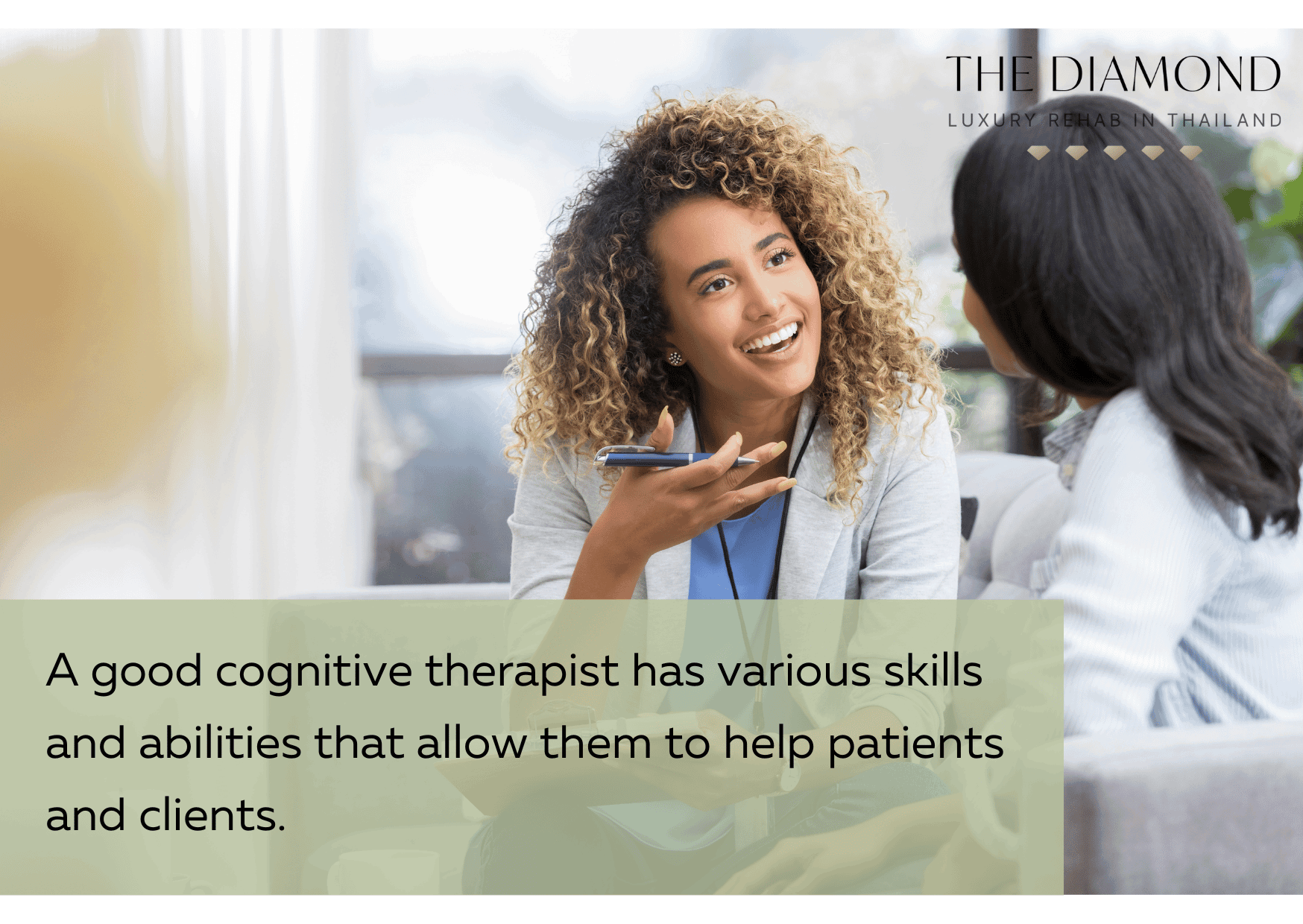
A licensed cognitive therapist performs cognitive therapy. In order to become a cognitive therapist, it’s necessary to meet various requirements regarding education level, courses, internships, and practice.
A good cognitive therapist has various skills and abilities that allow them to help patients and clients. They need people skills, meaning a cognitive therapist must be able to love working with people and collaborating with other healthcare professionals.
A cognitive therapist additionally needs to be compassionate and insightful, but not judgmental. They need excellent communication skills to instruct their patients on techniques of cognitive therapy so they’re able to change their irrational beliefs and thought patterns.
Additionally, a cognitive therapist needs analytical skills to draw conclusions from the information they gather from patients, problem-solving skills to create the most suitable treatment plan, and listening skills to truly understand the problems of their patients.
Cognitive therapists display wonderful observational abilities in the way they read people’s facial expressions, actions, reactions, body language, social interactions, behavior, and attitudes.
The skills and abilities of cognitive therapists don’t stop there. They extend to a thorough understanding of human development, business skills, strict adherence to patient confidentiality, understanding of various mental health disorders, and a complete understanding of psychotherapeutic approaches.
What does a Cognitive therapist do?
A cognitive therapist aims to help patients identify their thoughts and behaviors, especially about their surroundings and relationships, so they regain more control over these thoughts and positively influence their behaviors. They additionally prescribe medications for the management of a specific mental health problem, if necessary.
The main scope of work is to talk with a patient, set goals for each session to make sure the time is spent productively, keep patients on track, and model healthier behaviors. The cognitive therapist reflects on a patient’s progress and regression. To help a patient get the most from therapy, the cognitive therapist tends to recommend various exercises they’re able to do between the sessions.
Exercises that cognitive therapists are likely to recommend depend on the specific needs of each patient. They usually include journaling, reading assignments, and practicing mindfulness and relaxation. The cognitive therapist further has the option to coach or use exposure therapy to decrease the intensity of fear in patients with anxiety. They give thought exercises and openly challenge a patient’s beliefs as well. Finally, another important role of a cognitive therapist is to do all paperwork that makes it easy to track how far a patient has come.

Is Cognitive therapy effective?
Cognitive therapy is effective, which is confirmed by multiple scientific studies over the decades after its development. Back in 1983, when cognitive therapy started gaining popularity, the Journal of the Royal Society of Medicine published a study by MG Gelder that showed that cognitive therapy exhibited a powerful therapeutic effect on the management of depression.
Later, the Journal of Consulting and Clinical Psychology published a review by KS Dobson titled, “A meta-analysis of the efficacy of cognitive therapy for depression” which confirmed that when compared to alternative psychotherapies, medication, behavior therapy, waiting lists, or no treatment at all, cognitive therapy produced a higher degree of change.
The most recent piece of evidence on this subject was a paper by Elices et al., published in the February 2022 issue of the Mindfulness journal. The study focused on the role of mindfulness-based cognitive therapy in the management of depression. Results showed the treatment can be efficiently and securely administered in primary care settings. The intervention proved to be most effective for those with severe depression, as 35.6% of them were deemed to have achieved recovery.
Cognitive therapy and CBT effectively treat patients with unipolar major depression. In fact, according to studies, cognitive therapy is just as successful at treating depression as pharmaceuticals and interpersonal or psychodynamic therapy, as per a 2006 article written by Rupke et al., for the American Family Physician.
Not only is CT effective on its own, but it additionally works well in combination with other approaches such as medications. The same paper confirmed the efficacy of cognitive therapy in relapse prevention.
In this aspect, cognitive therapy was more effective than medications. More precisely, patients had a lower risk of relapse after completing cognitive therapy than after discontinuing medications.

